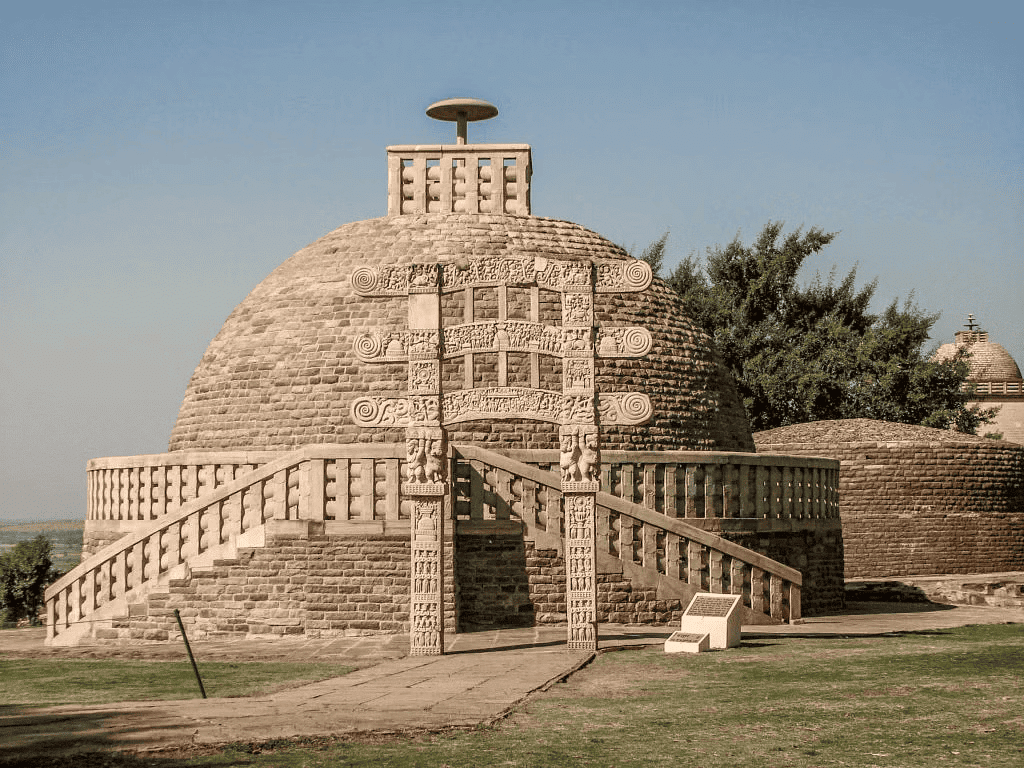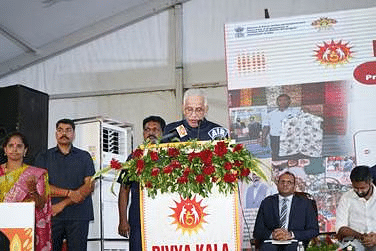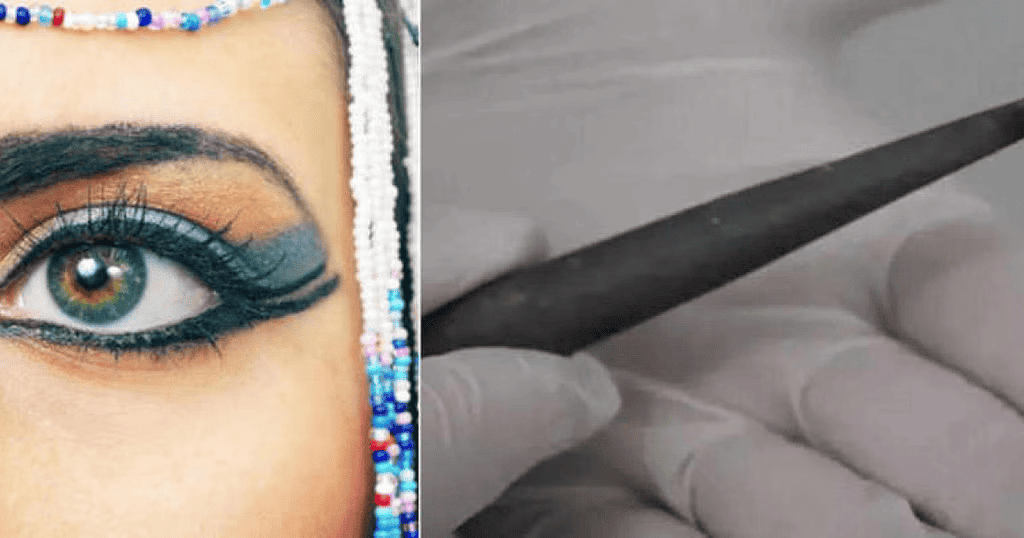History, Art and Culture: September 2024 Current Affairs | General Test Preparation for CUET UG - CUET Commerce PDF Download
Journey of Sanchi Stupa to Europe

Why in News?
Recently, India’s External Affairs Minister visited the replica of the East Gate of Sanchi Stupa standing in front of Humboldt Forum museum in Berlin, Germany. It is a 1:1 reproduction of the original structure standing at almost 10 metres high and 6 metres wide, and weighing roughly 150 tonnes.
Journey of East Gate of Sanchi Stupa to Europe
- The East Gate of Sanchi Stupa was created in plaster by Lieutenant Henry Hardy Cole for the Victoria and Albert Museum during the late 1860s.
- Several copies of this cast were later produced and displayed in various places across Europe.
- A plaster cast of the original gate has been exhibited in the entrance hall of the Königliches Museum für Völkerkunde Berlin since 1886.
- In 1970, a cast of this preserved copy was made using artificial stone.
- The most recent replica in Berlin also originates from this original cast.
- This latest version was created with modern techniques, including 3D scanning, advanced robots, and the expertise of both German and Indian sculptors, along with enlarged photos of the original torana for reference.
What are Key Facts about the Sanchi Stupa?
1. Construction of Sanchi Stupa: It was built by Ashoka in the third century BC
- The construction was supervised by Devi, who was the wife of Ashoka and came from the nearby trading town of Vidisha.
- The Sanchi complex received support from the wealthy business community of Vidisha.
2. Expansion: During the 2nd century BC (Shunga period), the stupa was enlarged with sandstone slabs, a circumambulatory walkway, and a harmika with a chattra (umbrella).
- From the 1st century BC to the 2nd century AD, four stone gateways, known as toranas, were constructed.
- These gateways were richly decorated with intricate carvings.
- The carvings depicted various Buddhist symbols and stories.
3. Rediscovery of Sanchi Stupa: It was in abject ruins when it was discovered by British officer Henry Taylor in 1818.
- Alexander Cunningham led the first formal survey and excavations at Sanchi in 1851.
4. Preservation Efforts: In 1853, Sikander Begum of Bhopal offered to send Sanchi gateways to Queen Victoria, but the removal plans were delayed due to the 1857 revolt and transportation issues.
- In 1868, the Begum made the offer again, but the colonial leaders said no. They chose to preserve the site as it was, rather than moving anything.
- Instead, a plaster cast of the eastern gateway was made to represent it.
- The site was restored to its current state in the 1910s by John Marshall, who was the director-general of the Archaeological Survey of India (ASI).
- This restoration was funded by the begums from nearby Bhopal.
5. Architecture of Sanchi Stupa:
- Anda: This is a round mound made of earth.
- Harmika: A square railing placed on top of the mound, thought to be the dwelling of a deity.
- Chattra: An umbrella structure that sits on top of the dome.
- Yashti: The central post that supports a three-tiered umbrella structure known as chattra.
- Railing: A boundary that surrounds the stupa, marking the sacred area and separating the holy space from the outside world.
- Pradakshinapatha (Circumambulatory Path): A path that goes around the stupa, allowing worshippers to walk in a clockwise manner.
- Torana: A grand gateway or entrance found in the architecture of Buddhist stupas.
- Medhi: The base that acts as a platform for the main structure of the stupa.
6. UNESCO Recognition: Sanchi Stupa was inscribed as a UNESCO World Heritage site in 1989.
What are the Key Features of the Gateways of Sanchi Stupa?
Construction: The four gateways, known as toranas, were built facing the four main directions in the first century BCE.
- These gateways were constructed over several decades during the rule of the Satavahana dynasty.
Structure: Each gateway features two square pillars that hold up a superstructure made of three curved architraves (or beams) with spirally-rolled ends.
Engravings: The pillars and architraves are beautifully decorated with reliefs and sculptures that show scenes from the life of the Buddha, stories from the Jataka tales, and other Buddhist symbols.
- These decorations include the shalabhanjika (a symbol of fertility depicted as a yakshi holding a tree branch), as well as images of elephants, winged lions, and peacocks.
- Notably, the gateways do not show the Buddha in a human form.
Philosophical Significance: The three curved architraves have important meanings:
- Upper Architrave: This represents the seven Manushi Buddhas (previous incarnations of the Buddha).
- Middle Architrave: This shows the scene of the Great Departure, when Prince Siddhartha leaves Kapilavastu to become an ascetic in search of enlightenment.
- Lower Architrave: This depicts Emperor Ashoka visiting the Bodhi tree, where the Buddha achieved enlightenment.
Conclusion
- The Sanchi Stupa is a significant example of ancient Buddhist architecture and faith.
- It is recognized as a UNESCO World Heritage site, which highlights its importance and beauty.
- The stupa continues to be a source of inspiration and scholarly interest around the world.
- It serves as a connection between the historical past and the modern global appreciation of cultural heritage.
- A recent example of this appreciation is seen in Germany, where a replica of the East Gate of the Sanchi Stupa has been built.
- This illustrates the global significance of preserving such monuments.
19th Edition of Divya Kala Mela

Why in News?
The 19th Divya Kala Mela was recently launched in Visakhapatnam by Governor Shri S. Abdul Nazeer, with support from dignitaries like Union Minister Dr. Virendra Kumar. This event is focused on empowering artisans with disabilities (Divyang artisans) and promoting inclusivity in society.
Financial Support and Initiatives
- 10 Divyang beneficiaries received special loans totaling ₹40 lakh.
- These loans were provided by the National Handicapped Finance and Development Corporation (NDFDC).
- The purpose of these loans is to assist individuals with disabilities in starting or expanding their own businesses.
- This initiative is a step towards helping these individuals achieve financial independence.
Showcasing Talents
- More than 100 Divyang artisans participated in the mela from 20 states and Union Territories.
- They showcased a variety of products, including handicrafts, handlooms, and packaged foods.
- The event supports the government's "Vocal for Local" initiative.
- This initiative aims to boost the local economy by promoting products made by local artisans.
- It helps artisans achieve financial independence.
Event Details
- The fair will be open from September 19 to 29.
- It will run every day from 11:00 AM to 9:00 PM.
- The location is Marine Ground at Andhra University.
- Visitors can enjoy cultural performances by Divyang artists.
- There will be food stalls featuring regional cuisines from all over India.
Commitment to Inclusion
- Dr. Virendra Kumar and other important figures spoke at the event.
- They stressed the significance of events like this for boosting the economic power of people with disabilities.
- The speakers also highlighted their dedication to hygiene, social welfare, and community responsibility.
- They reinforced the need for inclusion in society.
About Divya Kala Mela
- Divya Kala Mela is a yearly festival that highlights the skills of artists with disabilities.
- The event is organized by the Ministry of Social Justice and Empowerment.
- The main goal of the mela is to promote inclusivity and raise awareness about the talents of Divyang artists.
- It features various activities, including:
- Exhibitions showcasing artwork
- Performances by artists
- Cultural activities that celebrate diversity
- The festival aims to enhance the livelihoods of artisans by providing them a platform to display their work.
- The first Divya Kala Mela took place in 2016.
- Since then, it has been held in different Indian cities each year.
- The festival represents empowerment through art and entrepreneurship.
Angkor Wat Named Most Photogenic UNESCO Site in Asia

Why in News?
Cambodian Prime Minister Hun Manet shared exciting news: Angkor Wat was named the most photogenic UNESCO World Heritage site in Asia by Times Travel. This recognition was highlighted in a list published by the Times of India, which also included other famous landmarks across Asia.
What other sites were included in the list?
- Taj Mahal (India) – Famous for its stunning beauty and beautiful marble design.
- Hampi (India) – This ancient city is filled with temples and historic ruins.
- Great Wall of China (China) – A huge structure that offers amazing views of the landscape.
- Ancient City of Bagan (Myanmar) – Known for its many temples and pagodas, making it a unique site.
- Borobudur (Indonesia) – The largest Buddhist temple in the world, remarkable for its architecture.
- Ha Long Bay (Vietnam) – A beautiful bay famous for its limestone islands and clear green waters.
- Historic Monuments of Kyoto (Japan) – Features lovely temples and peaceful gardens.
- Petra (Jordan) – A city uniquely carved into rock, recognized for its distinct buildings.
- Rice Terraces of the Philippine Cordilleras (Philippines) – Remarkable, centuries-old rice fields built into the mountains.
- These places are not only important for their culture but are also visually stunning, making them great for photography.
Tourism Insights
- Angkor Wat is the most popular tourist spot in Cambodia.
- In the first eight months of 2024, it attracted 651,857 international visitors.
- This is a 30.7% increase compared to the same period last year.
- During this time, ticket sales earned $30.3 million.
- This shows a 31% growth in revenue.
- These figures underline the significance of Angkor Wat as a key cultural and historical site.
- It is considered a must-visit location in Southeast Asia.
About Angkor Wat
- Angkor Wat was constructed in the early 12th century.
- It is the largest religious monument in the world.
- The temple was initially built to honor the Hindu god Vishnu.
- Over time, it became a site for Buddhism.
- The entire temple complex covers more than 162 hectares (about 400 acres).
- It features over 5,000 sculptures.
- The design of Angkor Wat symbolizes a miniature model of the universe made of stone.
- Despite its impressive size and beauty, Angkor Wat was mostly forgotten by Western society until the 19th century.
- The walls of the temple are adorned with bas-reliefs that illustrate both historical and mythical tales.
- Since 1992, Angkor Wat has been designated as a UNESCO World Heritage Site.
Oldest Eyeliner Discovered in Turkey’s Ancient Prehistoric City

Why in News?
Archaeologists have recently found the oldest known kohl stick, a type of ancient eyeliner, at an archaeological site called Yeşilova Höyük in Turkey. This discovery shows that people have been using makeup for more than 8,000 years.
The Discovery
- The kohl stick is crafted from a green serpentine stone and has some black paint on its tip.
- It dates back over 8,200 years, making it the oldest proof we have of people using cosmetics.
- Zafer Derin, the main archaeologist, noted that kohl has been utilized in various cultures throughout history.
- This cosmetic was often found in places like Egypt, the Levant (which is the eastern Mediterranean), and Anatolia (now known as modern-day Turkey).
- Kohl was used not only for enhancing beauty but also for medicinal purposes.
- The discovery of this kohl stick indicates that even 8,200 years ago, women in the Aegean region of Yeşilova were interested in improving their appearance.
Physical Details of the Kohl Stick
- The kohl stick measures about 10 cm in length and 1 cm in thickness.
- It is finely crafted, resembling a pen, which indicates that people in the past had advanced skills in making tools for precise use.
- To use the kohl stick, individuals likely dipped it into kohl powder and applied it to their eyes as makeup.
- The black material found on the tip of the stick is thought to include manganese oxide, a common component in traditional kohl.
Kohl’s Medicinal and Cultural Uses
- Besides being a cosmetic, kohl was also used for eye care.
- Ancient writings indicate that it was thought to help treat eye diseases and shield the eyes from sunlight when applied in thick layers around the eyes.
- Kohl was typically made by grinding a mineral known as stibnite, which can be found in hydrothermal deposits.
- The finely ground powder was then applied around the eyes to create a dark-lined look.
- The discovery of the oldest kohl stick shows that the use of makeup has a long history, serving both cosmetic and medicinal purposes.
- It also highlights the advanced craftsmanship of ancient civilizations, particularly in the field of personal care and beauty.
|
164 videos|800 docs|1156 tests
|
FAQs on History, Art and Culture: September 2024 Current Affairs - General Test Preparation for CUET UG - CUET Commerce
| 1. What is the significance of the Sanchi Stupa in the context of art and culture? |  |
| 2. What are the highlights of the 19th Edition of Divya Kala Mela? |  |
| 3. Why was Angkor Wat named the most photogenic UNESCO site in Asia? |  |
| 4. What is the significance of the oldest eyeliner discovered in Turkey’s ancient prehistoric city? |  |
| 5. How do historical sites like Sanchi Stupa and Angkor Wat contribute to our understanding of world history? |  |
















